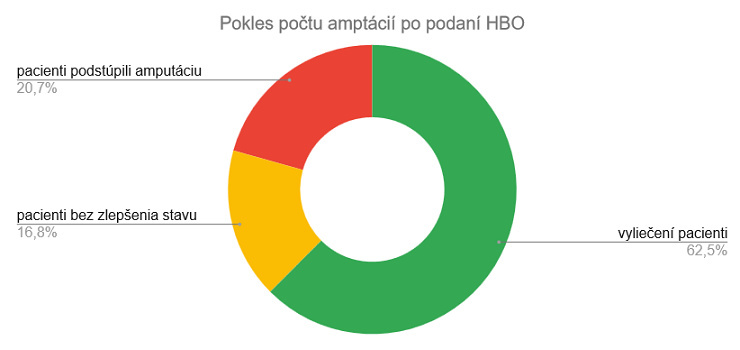Diabetic foot
In Slovakia, 300,000 people currently suffer from diabetes, which is an increase of more than a 50% over 20 years. One very common and serious complication of diabetes is diabetic foot or diabetic foot syndrome. Almost 8,000 diabetics suffer from diabetic foot. The main factors leading to diabetic foot are limb ischemia and neuropathy (nerve supply disorders) of the limb. Diabetic foot occurs as a result of impaired vascular circulation mainly on the lower leg and foot. Due to insufficient oxygen supply to the lower extremities, the death of the toes often occurs. This is followed by the necessary surgical intervention - amputation. The resulting wound, despite regular treatment, is very difficult and to heal over a long time.
DIABETES AND HYPERBARIC OXYGEN THERAPY IN SLOVAKIA
The number of limb amputations due to diabetic foot in Slovakia is growing every year, because we do not use all treatment options, including treatment in a hyperbaric chamber. More than 4,000 diabetics have had their legs amputated and more amputations are added every year. This growing trend can be reduced by diagnosis and properly guided treatment. Early diagnosis and detection of a health problem and properly indicated treatment for healing the wound of a diabetic foot can significantly help patients improve their condition.
Patients do not receive adequate health care and information about possibilities for treatment in a hyperbaric chamber, which can help most patients with diabetes with diabetic foot. Diabetic foot poses a great risk of limb amputation for many diabetics. Amputations can be avoided through hyperbaric oxygen therapy treatment.
TREATMENT OF DIABETIC FOOT
Treatment in a hyperbaric chamber helps speed healing. The treatment ensures sufficient supply of oxygen even to those tissues that are normally poorly oxygenated. The supply of oxygen also improves the effect of drugs or antibiotics. The results of the treatment are very good, which is also evident in the following photos. However, it goes without saying that the treatment is long-term and often requires up to 30 treatment visits in the chamber. We have been successful in the treatment of diabetic foot and in the treatment of wounds that in many cases were so extensive that there was a risk of amputation of limbs. Treatment with hyperbaric oxygen therapy has a beneficial effect on the healing of diabetic wounds (ulcers).
HYPERBARIC OXYGEN THERAPY IS AN EFFECTIVE METHOD OF TREATING DIABETIC FOOT
- Accelerates healing
- Reduces the risk of high amputation by 60%
- Increases the proportion of completely healed diabetic wounds in the long run
DIABETES AND HYPERBARIC OXYGEN THERAPY ABROAD
Diabetes affects more than 12 million people each year and is the seventh leading cause of death in the United States. Diabetes mellitus primarily affects smaller blood vessels and hyperbaric oxygen therapy has been shown to increase stimulation of angiogenesis (blood vessel formation), which in turn helps to reduce the consequences of weakened blood circulation and helps prevent organ failure.
Research has shown that HBO can lower blood sugar levels by increasing cellular sensitivity to insulin and glucose uptake in skeletal muscle tissue. In addition, recent research has provided evidence of a link between HBO and the regeneration of the islets of Langerhans of the pancreas, which could potentially lead to higher insulin production. HBO often has a beneficial effect in the process of treating osteomyelitis and cellulite and, in addition, has a preventive effect against systemic toxicity and permanent disability.
Chronic diabetes causes weakened blood flow, complicating wound healing and leading to ulceration (ulceration). HBO increases the volume of oxygen available to tissues in the ulcer area, and this leads to increased activation of fibroblasts.
STUDIES HAVE SHOWN THE FOLLOWING BENEFICIAL EFFECTS OF HBO FOR PATIENTS WITH DIABETES:
HBO’S ROLE IN IMPROVING BLOOD CHEMISTRY PROFILE
- Fasting sugar level
- Haemoglobin HbA 1C
- Lipid profiles
ADVANCED GLYCAEMIC CONTROL WITH HBO
- Increases the number of islets of Langerhans of the pancreas
- Improves insulin sensitivity
- Increases glucose uptake in skeletal muscle
HBO’S ROLE IN REDUCING CARDIOVASCULAR RISK
- Promotes long-term blood pressure control
- Relieves metabolic syndromeReduces the risk of sudden heart attack caused by ventricular arrhythmia
THE ROLE OF HBO IN STIMULATING VASCULAR FORMATION AND SUPPRESSING INFLAMMATORY PROCESSES
- Improves brain function and reduces the risk of stroke
- Improves heart function and reduces the risk of heart attack
- Reduces the risk of diabetic retinopathy
- Reduces the risk of diabetic neuropathy
- Minimizes the risk of diabetic nephropathy
- Suppresses cellulite
HBO’S ROLE IN IMPROVING INTERNAL AND EXTERNAL HEALING
- Expands epithelialization
- Promotes closure of non-healing wounds
- Suppresses the formation of ulcers
- Reduces the risk of amputation
STUDY: DECLINE IN AMPUTATIONS AFTER HBO ADMINISTRATION
In 2008, a study was published that evaluated the effectiveness of HBO in reducing the number of amputations in patients with diabetic lower limb ulcer.
A total of 184 patients underwent an average of 39 HBO therapies (60 to 120 minutes daily, six days a week, progress assessed at 3, 6, and 12 months) as adjunctive therapy along with the standard method of treating diabetic lower limb ulcer. At the end of treatment, a total of 115 patients (62 percent) had recovered completely, 31 (17 percent) showed no improvement, and 38 (21 percent) had undergone amputation. The success of HBO is illustrated by the alleviation of the consequences of insufficiently oxygenated (hypoxic) tissue using mechanisms such as angiogenesis, fibroblast replication, collagen synthesis, vascular reformation (revascularization), epithelization and increased bactericidal activity of leukocytes. The study thereby confirmed that HBO can help reduce the rate of amputations in diabetic lower limb ulcers by restoring the affected tissue. This finding is particularly significant considering the failure of other conventional treatments.
Diabetic foot – a decrease in the number of amputations after HBO administration
(Fall in the number of amputations after administration of HBO.
Patient underwent amputation 20.7%
Patient without improvement 16.8%
Patient recovered 62.5%)

